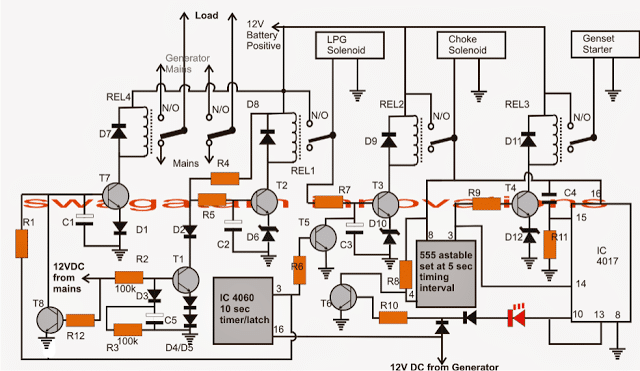In this article we investigate an ATS circuit for initiating an automatic changeover from mains supply to generator supply through many intermediate transfer stages which involves activating the fuel valve, choke valve and the generator starter. The circuit was requested by Mr. Hari, and another dedicated reader from this blog.
Requirement for 5kva LPG Generator
I'm Hari, from Indonesia. Thank you for your circuit ideas, i made a battery charger based on your design. Right now, i'm looking for Automatic Transfer Switch (ATS) for my portable generator.
It's 5000VA LPG powered generator with electric starter. Buy ready to use ATS is very expensive, i want to make it myself. Can you help me design the ATS? Right now, i need to shut off the LPG valve manually to turn off my generator.
I have plan to add LPG solenoid valve so i can close/open the LPG supply electrically. And add mechanic solenoid (push-pull, normally pull) to automate the choke.
The ATS system feature i need are:
- detect main supply, during normal condition (when main supply on), the ATS close the main to
load connection and open the generator to load connection - when main supply off, the ATS open the main supply to load connection, but keep the generator to load connection open.
- then, the system will activate LPG solenoid valve (normally closed) to open LPG supply to the engine and activate mechanical solenoid (normally pulled) to push the choke grip to START position
- after that, the ATS will send signal to the generator starter and start to crank the generator automatically maximum for 5 seconds. If the engine fails to start within 5 seconds, the system will stop for at least 5 second before attempting to start the engine again.
- When 3rd trial fails, the system activate an alarm (it could be flashing light or sound).
- if the starter succeeds, and the generator runs, the system will wait for 10 seconds then the system will:
- deactivate mechanical solenoid so that it pulls the choke grip back to CLOSE position.
- after this, finally the system will close the connection between generator to load.
- if the main power back, the ATS will open the generator to load connection, and keep the generator run without load for 2 minutes and turn the generator off by deactivate LPG solenoid valve.
- several seconds later, the system will open the generator to load connection, it close the connection between main to load connection
Second Request
Sir in my area, we have problem of load-shading. i want a circuit (system) to automatically turn ON a self start gas generator (6 KVAR) when Light (Grid Supply) goes OFF and load should shift to generator by itself.
And when Light (Grid Supply) is back, automatically turns OFF generator and load should be connected to gird Supply..
I know a system using automatic change over and a relay. it is only to automatically turn off generator and shift to Grid..automatic change over is used to shift from generator to Grid and relay is used only to turn off generator..
Sir, please tell me a system so that we can make our task easy to turn on and turn off generator. I think there may be a system such that when light goes off load automatically connects to generator, and we use remote or cell phone to turn on generator.
And to turn off there is already an automatic system...
Design#1: Operational Details
The ATS circuit or automatic relay changeover for generator/ mains circuit as shown below can be understood as follows:
For so long as home mains is present T1 base receives the rectified low voltage DC and keeps T2 base grounded.
With T2 base grounded REL1 is held switched OFF along with REL2, REL3 and REL4, the whole circuit thus stays switched OFF.
With REL4 deactivated, the DPDT holds the home mains supply with the load and the load gets powered via its N/C contacts.
Now in a situation when home mains fails, T1 is inhibited from its base drive and it instantly stops conducting.
With T1 OFF, T2 now activates, switching ON REL1, which in turn activates the LPG solenoid valve for allowing the fuel to reach generator combustion chamber.
After a few seconds delay T3/REL2 also activate pushing ON the choke solenoid into start position. The delay may be fixed by the tweaking the values of R7, C3.
REL2 activation switches ON the 555 astable which starts counting upto 5 seconds and triggers T4/REL3 so that the generator starter motor begins cranking the gen.
The astable allows this to happen for 5 seconds, if the generator starts, a 12V supply from a 12V adapter connected at the output of the generator feeds T6 base and disables the 555 astable.
The above 12V from the gen also activates the 4060 timer/latch which counts for about 10 seconds after which its pin#3 goes high.
The pin#3 high pulse latches the IC and also feeds T5 which deactivates REL2 so that the choke solenoid is pulled back to "close" position.
The 4060 output also simultaneously activates T7/REL4 making sure that the load now gets connected to the generator AC via N/O contacts of REL4.
Now suppose due to some fault, the cranking of the generator starter fails to initiate the generator, the astable makes three attempts with 5 seconds interval between each try.
Since the above pulses also reach IC4017 counter, after three pulses the IC4017 output sequence reaches its pin#10 which instantly latches itself due to a high at pin#13, and also disables the 555 astable by grounding its reset pin#4 via T6.
REL3 now stops feeding the crank mechanism.
An additional transistor driver/RELAY may be configured with pin#10 of IC 4017. The N/O contacts of this relay then could be wired with an alarm for the required warning in case the cranking attempts fails to start the generator.
When mains AC returns, T1 receievs the atached 12VDC at its base, however due to the presence of R2, D3, C5, T1 is restricted from the base voltage for a few seconds, until C5 charges.
In the meantime T7 is disabled and REL4 reverted to home mains position by T8, this happens as soon as mains returns, so that the generator gets immediately unloaded from the connected appliances.
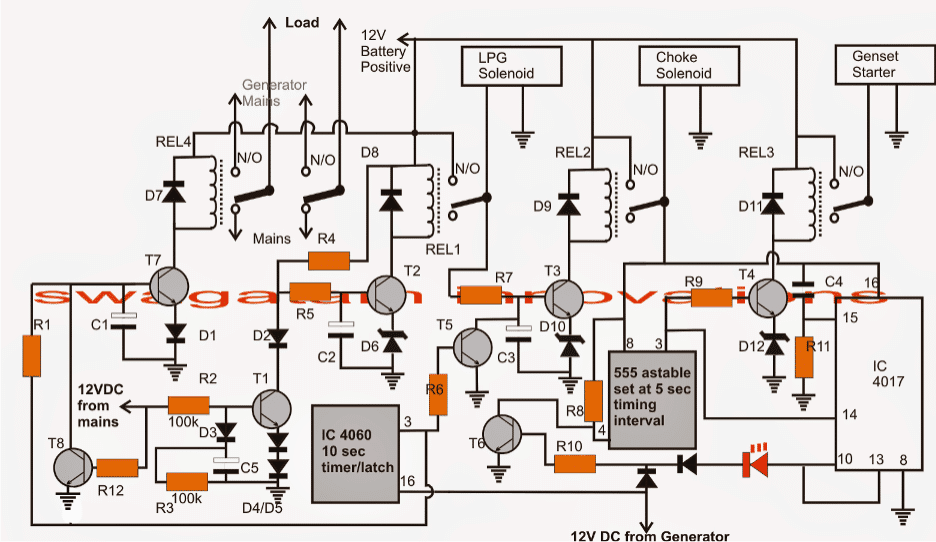
Parts list for the above automatic transfer switch or ATS circuit
R1, R4, R5, R6, R7, R8, R9, R10, R11 = 10K
R2, R3 = 100K
C4 = 0.1uF
C1----C5 = timing capacitors, can be between 10uF to 100uF
All transistors are BC547
All rectifier diodes are = 1N4007
All zener diodes (D6, D10, D12) are = 3V, 1/2 watt
REL1---REL3 = 12V/10 amps/400 ohms
REL4 = 12V/40amps or as per load specs
IC 555 Astable Configuration
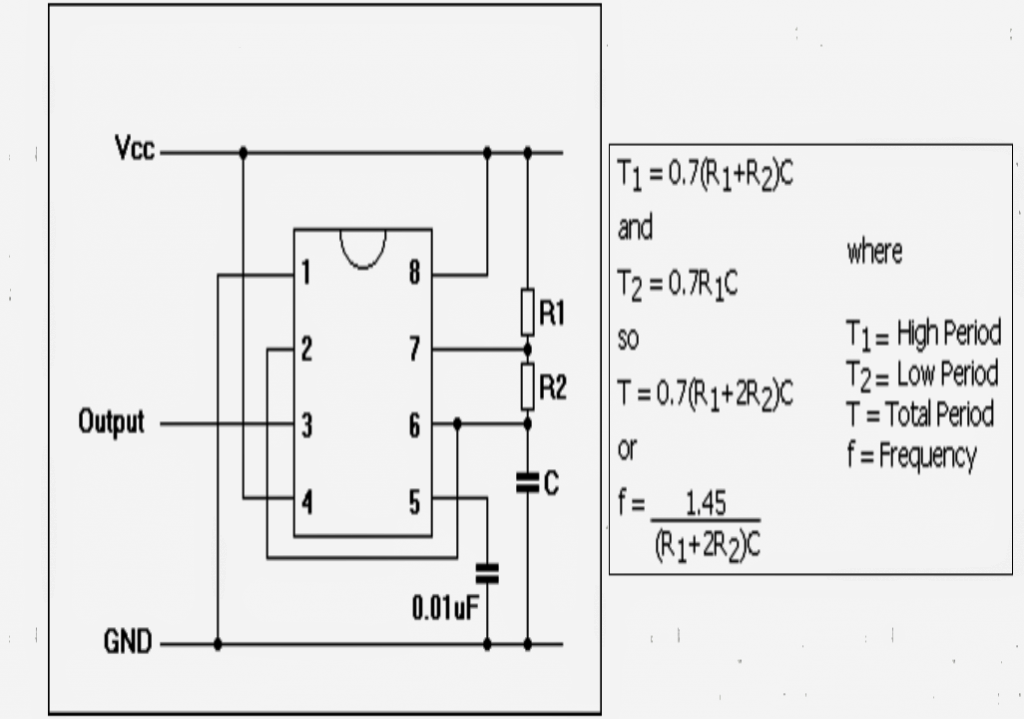
IC 555 Astable Frequency Formula
f = 1.45 / (R1 + 2R2)C
The following formula can be used for calculating the high time and low time periods or the ON/OFF time of the IC 555 astable:
On Time T1 = 0.7(R1 + R2)C
OFF Time T2 = 0.7R1C
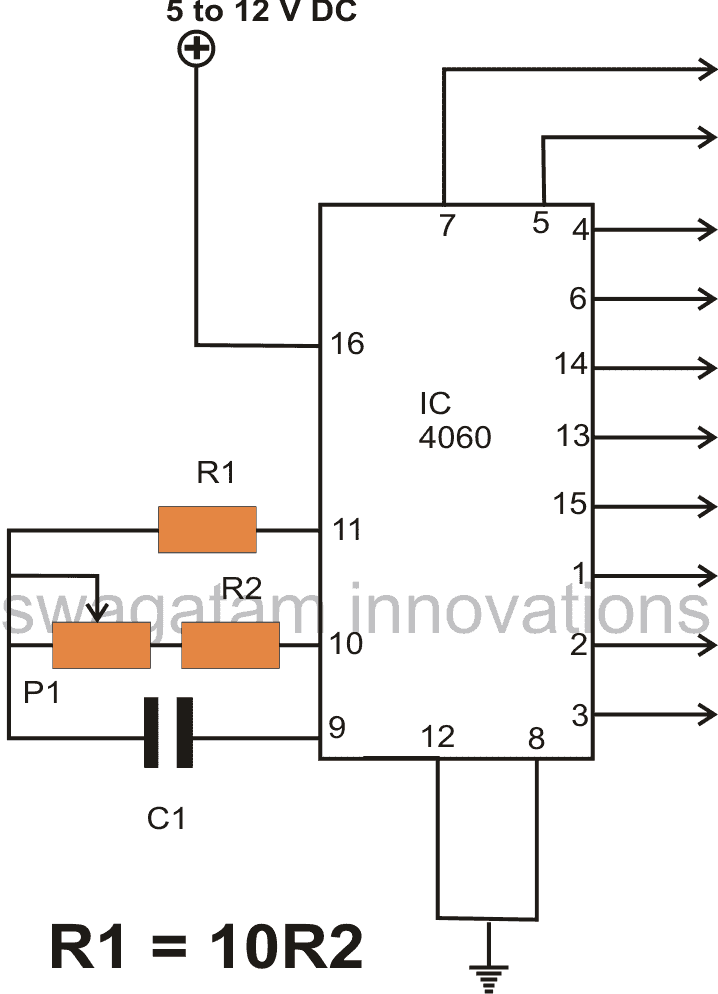
IC 4060 Timer Calculation and Formula
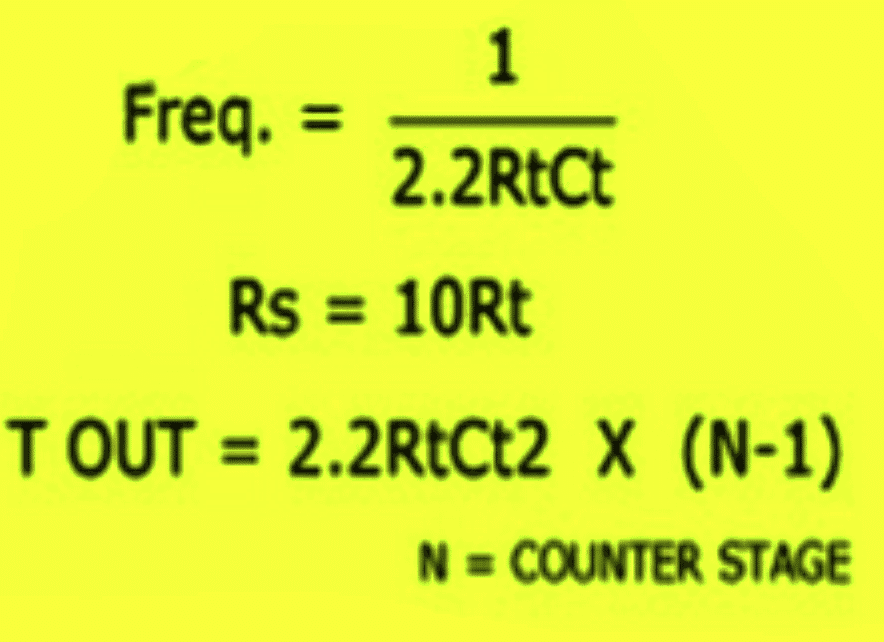
or you can also use the following formula:
f(osc) = 1 / 2.3 x Rt x Ct
2.3 is a constant term which will not need any change.
The oscillator section inside the IC will be able to give stable output only if the following criteria is maintained:
Rt << R2 and R2 x C2 << Rt x Ct.
Updated ATS Circuit Diagram with complete IC 4060 and IC 555 wiring details
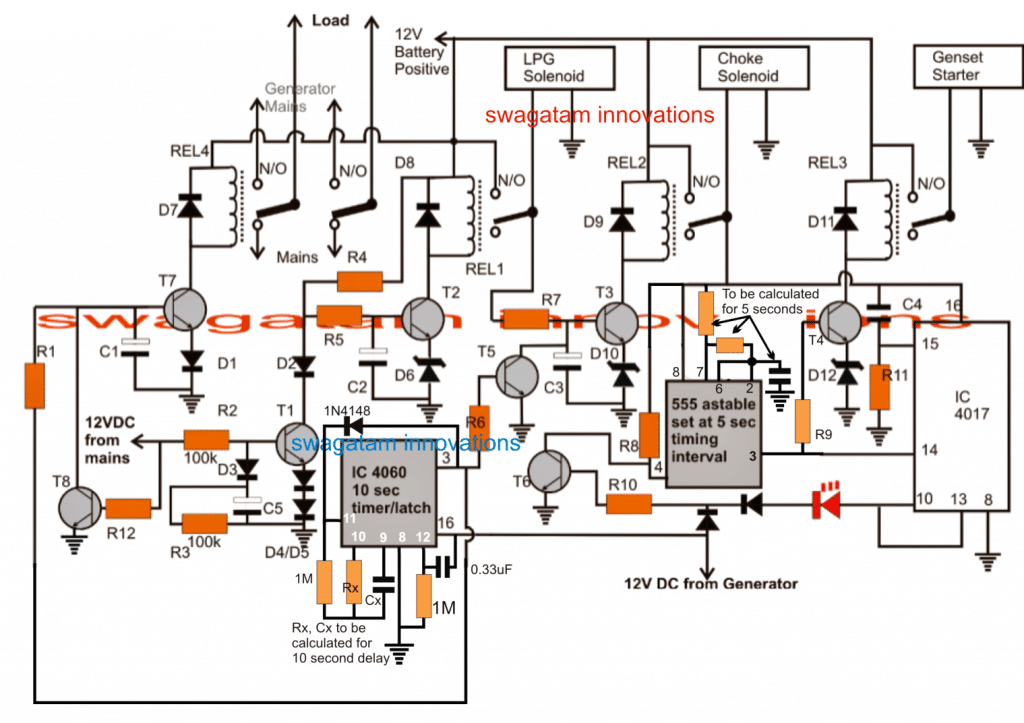
Design#2
In the following post I have explained an enhanced Automatic Transfer Switch (ATS) Circuit, which includes several customized sequential changeover relay stages making the system truly smart!
Designed and written by: Abu-Hafss.
Main Features
The circuit presented here is an ATS with following features:
a) Battery Voltage Monitor - The system will not operate when the battery drops to a certain preset level.
b) In the event of power failure, the generator engine will be cranked after 5 sec. The cranking cycle will be 2 minutes in which there will be 12 cranks of 5 sec. each with an interval of 5 sec.
c) As soon as the engine is started, the cranking will be stopped.
d) Initially the generator will start on PETROL and will shift to GAS after 10 seconds.
e) When Grid Mains is restored the load will be shifted to Mains immediately but the generator will be switched off after 10 sec.
Circuit Diagram
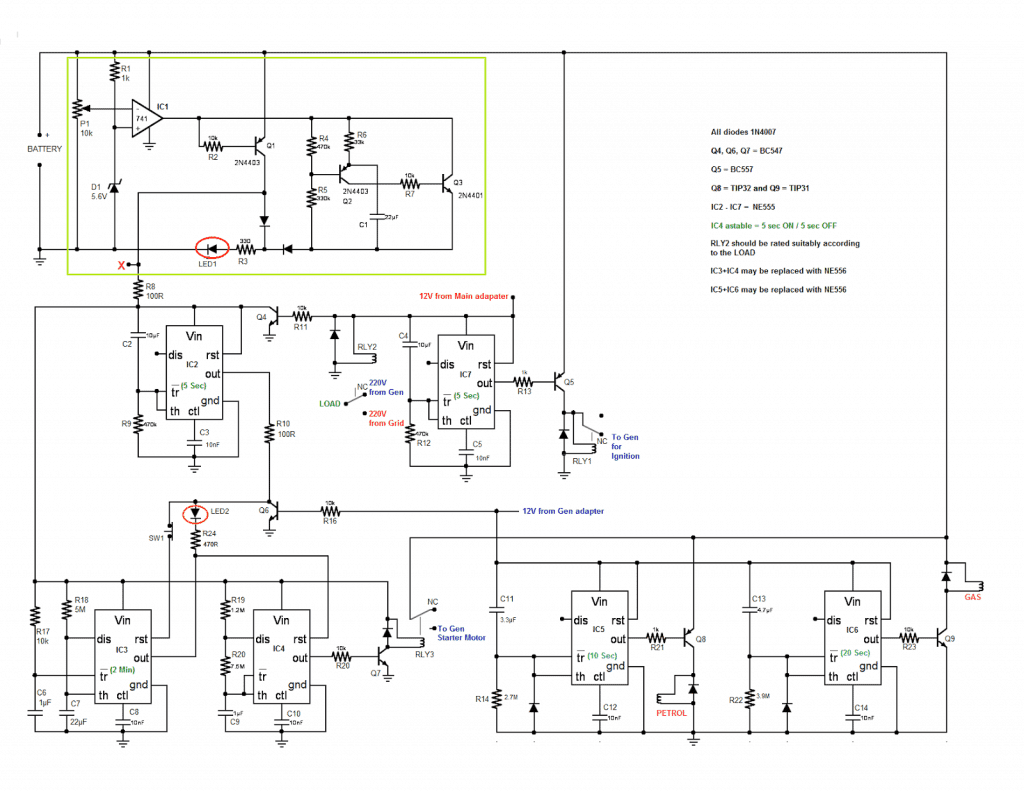
CIRCUIT DESCRIPTION:
1) The circuit enclosed in the green box makes up the battery monitor and it working may be understood here. If the generator is equipped with battery charging setup then this circuit might not be required because the battery will remain in good health. In that case, the entire circuit may be omitted and point X may be connected to the +(ve) of the battery.
2) When the Grid Mains goes off, the generator will be supplied with 12V via relay RLY1 for ignition i.e. RLY1 acts as an ignition switch and RLY2 shifts the LOAD to Generator 220V (which is not yet generated). The absence of grid Mains will switch off Q4 and as a result BATT 12V will be supplied to the rest of the circuit.
IC2, which is configured as "Power-on delay Timer" causes a delay of 5 sec and then resets IC3. IC3 is configured as self-triggering monostable having ON period of about 2 minutes. IC3 resets IC4 which is configured as an astable vibrator (about 5 sec ON and 5 sec OFF). During 2 minutes, IC4 cranks the generator (via R20/Q7/RLY3) 12 times for 5 sec with an interval of 5 sec.
If the engine does not starts within 2 minutes, LED2 will glow to indicate engine fault and the entire system will come to halt until the Grid Mains is restored. If required, the cranking procedure can be restarted by pressing the (Push-to-Off) reset button SW1.
3) Now, assuming that the engine has started during cranking, the generator will start producing electricity hence, 12V from generator adapter will be available. This will switch on Q6 hence, IC3 and IC4 will be powered off which ultimately stops the cranking cycle.
4) The 12V from generator will also power on IC5 and IC6. Both are configured as "Power-on Delay Timer" for about 10 sec and 20 sec respectively. For the initial 10 sec Q8 will conduct and the solenoid valve for PETROL will be opened to supply petrol to the generator. After 10 sec Q8 will stop conducting thereby stopping the petrol supply.
The engine will continue to run on petrol which present in the fuel lines. After about 10 sec the output of IC6 will become high and Q9 will start conducting. This will switch on the solenoid valve for GAS hence, the engine will now continue to run on gas.
5) Now, assuming the grid mains is restored, the 12V from mains adapter will switch on relay RLY2 which will switch the load immediately to the grid mains. The mains 12V will also switch on Q4 hence, IC2, IC3 and IC4 will be disconnected from the battery 12V.
The 12V mains will also power on IC7 which is configured as "Power-on Delay Timer". The output of IC7 will become high after about 5 sec which will switch off Q5 and de-energize RLY1, ultimately the 12V for generator will be switched off and the generator will be stopped.
